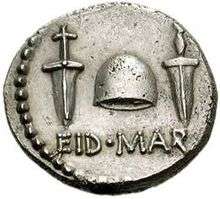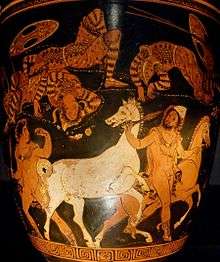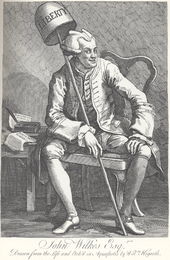Pileus (hat)

The pileus (Greek πῖλος – pilos, also pilleus or pilleum in Latin) was a brimless, felt cap worn in Ancient Greece[1] and surrounding regions, later also introduced in Ancient Rome. The Greek πιλίδιον (pilidion) and Latin pilleolus were smaller versions, similar to a skullcap.
The pileus was especially associated with the manumission of slaves, who wore it upon their liberation. It became emblematic of liberty and freedom from bondage.[2] During the classic revival of the 18th and 19th centuries in Europe it was widely confused with the Phrygian cap, (a similarly conical cap but which has the point softened and pulled forward) which, in turn, appeared frequently on statuary and heraldic devices as a "liberty cap.".
The pileus (plis in Albanian), is very common in Albania and Kosovo even today.
History

Greece
The pilos (Greek: πῖλος, felt[3]) was a common conical travelling hat in Illyria and Ancient Greece. The pilos is the brimless version of the petasos. It could be made of felt or leather. Pilos caps often identify the mythical twins, or Dioscuri, Castor and Pollux, as represented in sculptures, bas-reliefs and on ancient ceramics. Their caps were supposedly the remnants of the egg from which they hatched.[4] The pilos appears on votive figurines of boys at the sanctuary of the Cabeiri at Thebes, the Cabeirion.[5]
In warfare, the pilos type helmet was often worn by the peltast light infantry, in conjunction with the exomis, but it was also worn by the heavy infantry.
The pilos helmet was made of bronze in the same shape as the pilos which was presumably sometimes worn under the helmet for comfort, giving rise to the helmet's conical shape.[6] The first widespread adoption of the pilos helmet occurred in Sparta towards the end of the 5th century BC.[7]
Rome

In Ancient Rome, a slave was freed in a ceremony in which a praetor touched the slave with a rod called a vindicta and pronounced him to be free. The slave's head was shaved and a pileus was placed upon it. Both the vindicta and the cap were considered symbols of Libertas, the goddess representing liberty.[8] This was a form of extra-legal manumission (the manumissio minus justa) considered less legally sound than manumission in a court of law.
One 19th century dictionary of classical antiquity states that, "Among the Romans the cap of felt was the emblem of liberty. When a slave obtained his freedom he had his head shaved, and wore instead of his hair an undyed pileus."[9] Hence the phrase servos ad pileum vocare is a summons to liberty, by which slaves were frequently called upon to take up arms with a promise of liberty (Liv. XXIV.32). The figure of Liberty on some of the coins of Antoninus Pius, struck A.D. 145, holds this cap in the right hand.[10]
Gallery
- Ancient Greek pilos type helmet, 450 - 425 BC.
 Odysseus wearing the pilos. Ancient Greek red-figure situla from Apulia, ca. 360 BC, Museo Nazionale Archaeologico, Naples.
Odysseus wearing the pilos. Ancient Greek red-figure situla from Apulia, ca. 360 BC, Museo Nazionale Archaeologico, Naples.

 The pileus particularly identifies the Dioscuri (here on a colossal statue of late Antiquity in the Campidoglio, Rome).
The pileus particularly identifies the Dioscuri (here on a colossal statue of late Antiquity in the Campidoglio, Rome). John Wilkes depicted by Hogarth with the cap of Liberty on a pole, as it was sometimes carried in public demonstrations during the 18th century.
John Wilkes depicted by Hogarth with the cap of Liberty on a pole, as it was sometimes carried in public demonstrations during the 18th century. Ancient Greek helmets. Top line, from left to right: Illyrian type helmet, Corinthian helmet. Bottom line, from left to right: Phrygian type helmet, Pileus helmet with an olive branch ornament, Chalcidian helmet. Staatliche Antikensammlungen
Ancient Greek helmets. Top line, from left to right: Illyrian type helmet, Corinthian helmet. Bottom line, from left to right: Phrygian type helmet, Pileus helmet with an olive branch ornament, Chalcidian helmet. Staatliche Antikensammlungen
See also
- Traditional Albanian cap – Plis or Qeleshe
- Phrygian cap
- Attic helmet
- Barbute
- Boar's tusk helmet
- Boeotian helmet
- Chalcidian helmet
- Corinthian helmet
- Illyrian type helmet
- Kegelhelm
- Phrygian type helmet
- Zucchetto
References
Citations
- ↑ Encyclopædia Britannica
- ↑ http://pileusblog.wordpress.com/
- ↑ πῖλος, Henry George Liddell, Robert Scott, A Greek-English Lexicon, on Perseus
- ↑ John Tzetzes, On Lycophron, noted by Karl Kerenyi's The Heroes of the Greeks, 1959:107 note 584.
- ↑ Walter Burkert. Greek Religion, 1985:281.
- ↑ Nick Sekunda,The Spartan Army, p.30
- ↑ Jesse Obert, A Brief History of Greek Helmets, p.16
- ↑ Cobb, T.R.R. (1858). An inquiry into the law of Negro slavery in the United States of America. Philadelphia: T. & J.W. Johnson. p. 285, 285n2.
- ↑ πίλεον λευκόν, Diodorus Siculus Exc. Leg. 22 p. 625, ed. Wess.; Plaut. Amphit. I.1.306; Persius, V.82
- ↑ Yates, James. Entry "Pileus" in William Smith's A Dictionary of Greek and Roman Antiquities (John Murray, London, 1875).
Sources
 This article incorporates text from a publication now in the public domain: Chisholm, Hugh, ed. (1911). "article name needed". Encyclopædia Britannica (11th ed.). Cambridge University Press.
This article incorporates text from a publication now in the public domain: Chisholm, Hugh, ed. (1911). "article name needed". Encyclopædia Britannica (11th ed.). Cambridge University Press.
Further reading
- Sekunda, Nicholas and Hook, Adam (2000). Greek Hoplite 480–323 BC. Osprey Publishing. ISBN 1-85532-867-4
External links
- Institute of France – Greek Costume (PDF in French)
- Antiquitas – Casque corinthien et pilos
- A Brief History of Greek Helmets by Jesse Obert – AncientPlanet Online Journal Vol. 2 (2012), 48 – 59